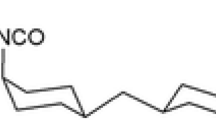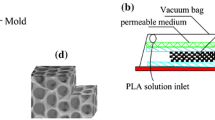Abstract
The microdomain structure of polyurethanes (PUR) determines their unique physical properties and makes polyurethanes attractive candidates for various tissue engineering applications. 3D scaffolds based on polyurethanes with different contents of hard segments were fabricated by a salt-leaching/polymer coagulation method. The process parameters were carefully considered, particularly the polymer solution concentration and characteristics of the polyurethane, which are the critical parameters for the control of porosity and pore size distribution. In this study, 3D polyurethane scaffolds were fabricated with interconnected pores and porosity from 64% to 80%. Pore size distribution was evaluated using quantitative image analysis and mercury intrusion porosimetry (MIP). The scaffolds fabricated from polyurethanes with 70 wt.% of hard-domain content were found to have the best compression properties.





Similar content being viewed by others
References
Palsson B, Hubbell JA, Plonsey R et al (2003) Tissue engineering. CRC Press, Boca Raton, Florida
Bronzino JD (2006) Tissue engineering and artificial organs. CRC Press, Boca Raton, Florida
Oh SH, Park IK, Kim JM et al (2007) Biomaterials 28:1664
Zhang Z, Wang Z, Liu S et al (2004) Biomaterials 25:177
Wei HJ, Liang H Ch, Lee MH et al (2005) Biomaterials 26:1905–1913
Whang K, Healy KE, Elenz DR et al (1999) Tissue Eng 5:35
Lu JX, Flautre B, Anselme K (1999) J Mater Sci Mater Med 10:111
Karageorgiou V, Kaplan D (2005) Biomaterials 26:5474
Hutmacher DW (2000) Biomaterials 21:2529
Zhang J, Zhang H, Wu L, Ding J (2006) J Mater Sci 41:1725. doi:https://doi.org/10.1007/s10853-006-2873-7
Draghi L, Resta S, Pirozzolo MG, Tanzi MC (2005) J Mater Sci Mater Med 16:1093
Chen G, Ushida T, Tateishi T (2001) Mater Sci Eng C 17:63
Mikos AG, Thorsen AJ, Czerwonka LA et al (1994) Polymer 35(5):1068
Van Tienen TG, Heijkants RGJC, Buma P et al (2002) Biomaterials 23:1731
Hou Q, Grijpma DW, Feijen J (2003) Biomaterials 24:1937
Kim SS, Park MS, Jeon O et al (2006) Biomaterials 27:1399
Hentze HP, Antonietti M (2002) Rev Mol Biotechnol 90:27
Lamba NMK, Woodhouse KA, Cooper SL (1997) Polyurethanes in biomedical applications. CRC Press, New York
Chen KS, Leon Yu T, Chen YS et al (2001) J Polym Res 82:99
Sanchez-Adsuar MS (2000) Int J Adhes Adhes 20:291
Ioan S, Grigorescu G (2002) Eur Polym J 38:2295
Tang YW, Labow RS, Santerre JP (2001) J Biomed Mater Res (2001) 56(4):516
Takahara A, Tashita J, Kajiyama T et al (1985) J Biomed Mater Res 19:13
Guan J, Fujimoto KL, Sacksa MS, Wagner WR (2005) Biomaterials 26:3961
Riboldi SA, Sampaolesi M, Neuenschwander P, Cossu G, Mantero S (2005) Biomaterials 26:4606
Grad S, Kupcsik L, Gorna K et al (2003) Biomaterials 24:5163
Zhang J, Doll BA, Beckman EJ et al (2003) J Biomed Mater Res 67A:389
Groot JH, Nijenhuis AJ, Bruin P et al (1990) Colloid Polym Sci 268:1073
Wojnar L, Kurzydłowski KJ, Szala J (2002) Praktyka analizy obrazu Polskie Towarzystwo Steorologiczne, Kraków
Ho ST, Hutmacher DW (2006) Biomaterials 27:1362
Hou Q, Grijpma DW, Feijen J (2003) Biomaterials 24:1937–1947
Heijkants RGJC, van Tienen TG, de Groot JH et al (2006) J Mater Sci 41:2423. doi:https://doi.org/10.1007/s10853-006-7065-y
Lee HK, Kimb JY, Kimb YD, Shinb JY, Kimb SC (2001) Polymer 42:3893
Nam YS, Park TG (1999) Biomaterials 20:1783
Hacker M, Ringhofer M, Appel B et al (2007) Biomaterials 28:3497
Reignier J, Huneault MA (2006) Polymer 47:4703
Acknowledgements
This scientific work was financially supported by the Ministry of Science and Higher Education, grant R1301901. The authors wish to thank Professor Andrzej Dworak and Dr. Barbara Trzebicka of Centre of Polymer and Carbon Materials Polish Academy of Sciences for the GPC measurements.
Author information
Authors and Affiliations
Corresponding author
Rights and permissions
About this article
Cite this article
Bil, M., Ryszkowska, J. & Kurzydłowski, K.J. Effect of polyurethane composition and the fabrication process on scaffold properties. J Mater Sci 44, 1469–1476 (2009). https://doi.org/10.1007/s10853-008-3037-8
Received:
Accepted:
Published:
Issue Date:
DOI: https://doi.org/10.1007/s10853-008-3037-8




